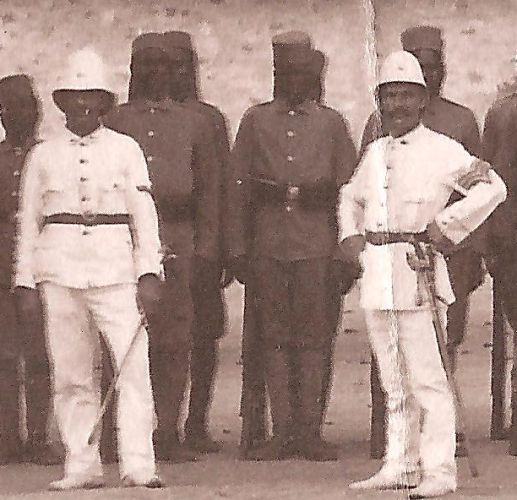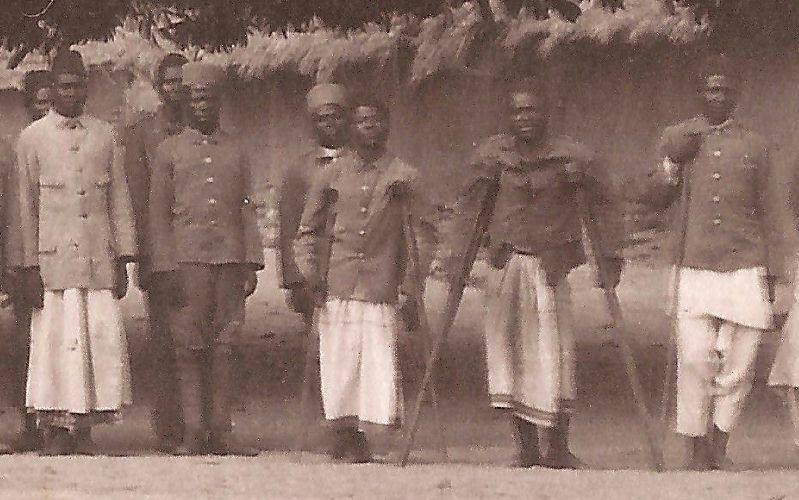|
This is a photograph of a
detachment of the German East African
Schutztruppe probably taken sometime between 1891 and 1900. It is not
known exactly where in East Africa this photograph was taken though
the men are probably the garrison of a small town. The caption
simply says "Askari u(nd). Invaliden b(eim). Appell", askaris and
invalids on roll call.
The unit presents a
total strength of two German NCOs, two African officers ("Effendi"),
one Askari Sergeant Major ("Sol"), six Askari junior NCOs on the far
left, twenty-two askari riflemen and a further twenty-one unarmed
Askari on the far right. These unarmed askari may be a combination
of gun carriers, German NCOs' servants or cooks. At least one is an
NCO himself and four are invalids on crutches.

A close up of the photograph showing two German NCOs in the
foreground. They are both wearing the
1891 Schutztruppe White
Tropicl Uniform with their distinctive crown buttons on the
collar, Brandenburg style cuffs and large curved rank chevrons. The
NCO on the left wears the single white metallic lace chevron of an
Unteroffizier, the NCO on the right wears the three chevrons of an
Feldwebel. They wear white tropical helmets with imperial cockades
on the front. This style of uniform was worn until replaced by new
regulations as of November 1896.
Both NCOs carry swords
whereas only the Feldwebel is entitled to according to the 1891
uniform regulations. Other photographs of this period show lower
ranking NCOs also carrying swords. The Feldwebel can clearly be seen
to have an officers sword knot ("Portepee") as befits his
rank. The Unteroffizier's sword knot cannot be seen.

Another close up of the photograph showing the
askaris and
their African Officers ("Effendi"). The three foreground figures
are from left to right, two Effendi and an African Sergeant
Major ("Sol").
The Effendi on the left wears a
khaki uniform similar to that worn by German officers with
Brandenburg cuffs and four pockets. His plain khaki shoulder
straps have a number of stars to denote his exact rank. The
number cannot clearly be seen but may be one ("Leutnant"),
two ("Oberleutnant") or three ("Hauptmann"). Later
all Effendi wore three stars and were of equal rank. He does not
appear to have crowns on his collar as the German NCOs do. He
wears matching khaki trousers worn loose over short brown
leather ankle boots. He wears an askari tarbush without imperial
eagle. He caries a sword from a brown leather belt with an open
buckle.
The Effendi in the centre wears
a white uniform similar to that worn by German officers with and
four pockets. The cuffs appear to be plain. His shoulder straps
cannot clearly be seen but may have a number of stars to denote his
exact rank. He does not appear to have crowns on his collar as the
German NCOs do. He wears matching white trousers worn loose over
short brown leather ankle boots. He wears an askari tarbush without
imperial eagle. He carries a sword from a brown leather belt with an
open buckle.
The Sol on the right wears the
same uniform as the askari other ranks behind him. It is typical
of the appearance of askaris in the early 1890s and consists of
a simple khaki tunic with a stand and fall collar, plain
shoulder straps and cuffs and five buttons up the front. The
trousers are matching khaki with dark blue/grey puttees and
short brown leather boots. Plain khaki tarbushes are worn
without insignia. All wear brown leather belts with plain brass
belt buckles. The Sol is distinguished by four rank chevrons on
his upper left arm. While the askaris behind him carry 1887
ammunition pouches and Jägerbüchse 71 rifles with S71/84
bayonets.

Another close up of the photograph showing
askari invalids on the right of the original photograph. They wear a
mixture of uniform and civilian clothing. Some wear the red off duty
fez.
The invalids all seem to be suffering some kind of foot injury or
lameness. They may well be are victims of one of many parasites
which in East Africa can cripple the barefooted. Ernst Nigmann's "Geschichte
der Kaiserlichen Schutztruppe in Deutsch Ost Afrika" (in English on
Battery Press)
describes how the Germans did trials with men in barefeet
(which the askaris often preferred), sandals and boots.
They found boots offered more protection and therefore produced less men
out of action. Boots were then insisted on and regular inspections
made of the men's feet. But from period photographs it seems there
were some who went barefoot at times. Conversely it is always
possible that these injuries were caused by long marches in ill
fitting boots.
Please respect the
generosity of
Karsten Herzogenrath in sharing this photograph with us by not reproducing it
without prior permission.
|